Detecting Temporal Trends in Straw Incorporation Using Sentinel-2 Imagery: A Mann-Kendall Test Approach in Household Mode
Abstract
1. Introduction
2. Materials and Methods
2.1. Study Area
2.2. Data Source
2.2.1. Sentinel-2 Remotely Sensed Data
2.2.2. Crop Type Data
2.2.3. Soil Moisture Data
2.2.4. Field Data
2.3. Methods
2.3.1. Spectral Indices
2.3.2. MK Test
2.4. Accuracy Assessment
3. Results
3.1. Validation of SI Inversion Accuracy
3.2. Analysis of SI Spatial Distribution in the Study Area
3.3. Correlation Analysis Between Spectral Indices and SI
4. Discussion
4.1. Comparative Analysis of BSI and STI Inversion Results
4.2. Impact of Household Mode on SI
4.2.1. Influence of Policy Factors
4.2.2. Influence of Economic Factors
4.3. Limitations and Prospects
5. Conclusions
Supplementary Materials
Author Contributions
Funding
Data Availability Statement
Conflicts of Interest
References
- Song, Y.; Zhang, B.; Wang, J.; Kwek, K. The impact of climate change on China’s agricultural green total factor productivity. Technol. Forecast. Soc. Chang. 2022, 185, 122054. [Google Scholar] [CrossRef]
- Alexander, P.; Arneth, A.; Henry, R.; Maire, J.; Rabin, S.; Rounsevell, M.D.A. High Energy and Fertilizer Prices Are More Damaging than Food Export Curtailment from Ukraine and Russia for Food Prices, Health and the Environment. Nat. Food 2022, 4, 84–95. [Google Scholar] [CrossRef]
- Falcon, W.P.; Naylor, R.L.; Shankar, N.D. Rethinking Global Food Demand for 2050. Popul. Dev. Rev. 2022, 48, 921–957. [Google Scholar] [CrossRef]
- Borrelli, P.; Lugato, E.; Montanarella, L.; Panagos, P. A New Assessment of Soil Loss Due to Wind Erosion in European Agricultural Soils Using a Quantitative Spatially Distributed Modelling Approach. Land Degrad. Dev. 2017, 28, 335–344. [Google Scholar] [CrossRef]
- Prăvălie, R.; Săvulescu, I.; Patriche, C.; Dumitraşcu, M.; Bandoc, G. Spatial Assessment of Land Degradation Sensitive Areas in Southwestern Romania Using Modified MEDALUS Method. CATENA 2017, 153, 114–130. [Google Scholar] [CrossRef]
- Zhu, Q.; Guo, X.; Guo, J.; Wu, J.; Ye, Y.; Cai, W.; Liu, S. The Quality Attribute of Watershed Ecosystem Is More Important than the Landscape Attribute in Controlling Erosion of Red Soil in Southern China. Int. Soil Water Conserv. Res. 2022, 10, 507–517. [Google Scholar] [CrossRef]
- Ma, L.; Kong, F.; Wang, Z.; Luo, Y.; Lv, X.; Zhou, Z.; Meng, Y. Growth and Yield of Cotton as Affected by Different Straw Returning Modes with an Equivalent Carbon Input. Field Crops Res. 2019, 243, 107616. [Google Scholar] [CrossRef]
- Yin, H.; Zhao, W.; Li, T.; Cheng, X.; Liu, Q. Balancing Straw Returning and Chemical Fertilizers in China: Role of Straw Nutrient Resources. Renew. Sustain. Energy Rev. 2018, 81, 2695–2702. [Google Scholar] [CrossRef]
- Wang, Y.; Wu, P.; Mei, F.; Ling, Y.; Qiao, Y.; Liu, C.; Leghari, S.J.; Guan, X.; Wang, T. Does Continuous Straw Returning Keep China Farmland Soil Organic Carbon Continued Increase? A Meta-Analysis. J. Environ. Manag. 2021, 288, 112391. [Google Scholar] [CrossRef]
- Huang, T.; Yang, N.; Lu, C.; Qin, X.; Siddique, K.H.M. Soil Organic Carbon, Total Nitrogen, Available Nutrients, and Yield under Different Straw Returning Methods. Soil Tillage Res. 2021, 214, 105171. [Google Scholar] [CrossRef]
- Wang, L.; Qin, T.; Liu, T.; Guo, L.; Li, C.; Zhai, Z. Inclusion of Microbial Inoculants with Straw Mulch Enhances Grain Yields from Rice Fields in Central China. Food Energy Secur. 2020, 9, e230. [Google Scholar] [CrossRef]
- Liu, H.Q.; Yang, J.H.; Liu, C.X.; Diao, Y.F.; Ma, D.P.; Li, F.H.; Rahma, A.E.; Lei, T.W. Flow Velocity on Cultivated Soil Slope with Wheat Straw Incorporation. J. Hydrol. 2020, 584, 124667. [Google Scholar] [CrossRef]
- Wu, G.; Ling, J.; Zhao, D.-Q.; Xu, Y.-P.; Liu, Z.-X.; Wen, Y.; Zhou, S.-L. Deep-Injected Straw Incorporation Improves Subsoil Fertility and Crop Productivity in a Wheat-Maize Rotation System in the North China Plain. Field Crops Res. 2022, 286, 108612. [Google Scholar] [CrossRef]
- Yao, Q.; Liu, J.; Yu, Z.; Li, Y.; Jin, J.; Liu, X.; Wang, G. Three years of biochar amendment alters soil physiochemical properties and fungal community composition in a black soil of northeast China. Soil Biol. Biochem. 2017, 110, 56–67. [Google Scholar] [CrossRef]
- Li, H.; Yao, Y.; Zhang, X.; Zhu, H.; Wei, X. Changes in Soil Physical and Hydraulic Properties Following the Conversion of Forest to Cropland in the Black Soil Region of Northeast China. CATENA 2021, 198, 104986. [Google Scholar] [CrossRef]
- Dong, Y.; Wu, Y.; Qin, W.; Guo, Q.; Yin, Z.; Duan, X. The Gully Erosion Rates in the Black Soil Region of Northeastern China: Induced by Different Processes and Indicated by Different Indexes. CATENA 2019, 182, 104146. [Google Scholar] [CrossRef]
- Wu, X.; Yang, Y.; He, T.; Wang, Y.; Wendroth, O.; Liu, B. Mechanical Sowing Alters Slope-Scale Spatial Variability of Saturated Hydraulic Conductivity in the Black Soil Region of Northeast China. CATENA 2022, 212, 106115. [Google Scholar] [CrossRef]
- Quan, Z.; Li, S.; Zhu, F.; Zhang, L.; He, J.; Wei, W.; Fang, Y. Fates of 15N-Labeled Fertilizer in a Black Soil-Maize System and the Response to Straw Incorporation in Northeast China. J. Soils Sediments 2018, 18, 1441–1452. [Google Scholar] [CrossRef]
- Xie, Y.; Lin, H.; Ye, Y.; Ren, X. Changes in Soil Erosion in Cropland in Northeastern China over the Past 300 Years. CATENA 2019, 176, 410–418. [Google Scholar] [CrossRef]
- Zheng, H.; Liu, W.; Zheng, J.; Luo, Y.; Li, R.; Wang, H.; Qi, H. Effect of Long-Term Tillage on Soil Aggregates and Aggregate-Associated Carbon in Black Soil of Northeast China. PLoS ONE 2018, 13, e0199523. [Google Scholar] [CrossRef]
- Wang, X.; Jia, Z.; Liang, L.; Zhao, Y.; Yang, B.; Ding, R.; Wang, J.; Nie, J. Changes in Soil Characteristics and Maize Yield under Straw Returning System in Dryland Farming. Field Crops Res. 2018, 218, 11–17. [Google Scholar] [CrossRef]
- Wang, Y.; Wang, S.; Adhikari, K.; Wang, Q.; Sui, Y.; Xin, G. Effect of Cultivation History on Soil Organic Carbon Status of Arable Land in Northeastern China. Geoderma 2019, 342, 55–64. [Google Scholar] [CrossRef]
- Han, X.; Zou, W. Effects and Suggestions of Black Soil Protection and Soil Fertility Increase in Northeast China. Bull. Chin. Acad. Sci. 2018, 33, 206–212. [Google Scholar]
- Kan, Z.-R.; Wang, Z.; Chen, W.; Virk, A.L.; Li, F.-M.; Liu, J.; Xue, Y.; Yang, H. Soil Organic Carbon Regulates CH4 Production through Methanogenic Evenness and Available Phosphorus under Different Straw Managements. J. Environ. Manag. 2023, 328, 116990. [Google Scholar] [CrossRef] [PubMed]
- Xiang, X.; Du, J.; Jacinthe, P.-A.; Zhao, B.; Zhou, H.; Liu, H.; Song, K. Integration of Tillage Indices and Textural Features of Sentinel-2A Multispectral Images for Maize Residue Cover Estimation. Soil Tillage Res. 2022, 221, 105405. [Google Scholar] [CrossRef]
- Li, J.; Yu, W.; Du, J.; Song, K.; Xiang, X.; Liu, H.; Zhang, Y.; Zhang, W.; Zheng, Z.; Wang, Y.; et al. Mapping Maize Tillage Practices over the Songnen Plain in Northeast China Using GEE Cloud Platform. Remote Sens. 2023, 15, 1461. [Google Scholar] [CrossRef]
- Najafi, P.; Navid, H.; Feizizadeh, B.; Eskandari, I.; Blaschke, T. Fuzzy Object-Based Image Analysis Methods Using Sentinel-2A and Landsat-8 Data to Map and Characterize Soil Surface Residue. Remote Sens. 2019, 11, 2583. [Google Scholar] [CrossRef]
- Wang, S.; Guan, K.; Zhang, C.; Zhou, Q.; Wang, S.; Wu, X.; Jiang, C.; Peng, B.; Mei, W.; Li, K.; et al. Cross-Scale Sensing of Field-Level Crop Residue Cover: Integrating Field Photos, Airborne Hyperspectral Imaging, and Satellite Data. Remote Sens. Environ. 2023, 285, 113366. [Google Scholar] [CrossRef]
- Tian, J.; Zhu, X.; Wan, L.; Collin, M. Impacts of Satellite Revisit Frequency on Spring Phenology Monitoring of Deciduous Broad-Leaved Forests Based on Vegetation Index Time Series. IEEE J. Sel. Top. Appl. Earth Obs. Remote Sens. 2021, 14, 10500–10508. [Google Scholar] [CrossRef]
- Woodcock, C.E.; Loveland, T.R.; Herold, M.; Bauer, M.E. Transitioning from Change Detection to Monitoring with Remote Sensing: A Paradigm Shift. Remote Sens. Environ. 2020, 238, 111558. [Google Scholar] [CrossRef]
- Zeng, L.; Wardlow, B.D.; Xiang, D.; Hu, S.; Li, D. A Review of Vegetation Phenological Metrics Extraction Using Time-Series, Multispectral Satellite Data. Remote Sens. Environ. 2020, 237, 111511. [Google Scholar] [CrossRef]
- Moon, M.; Seyednasrollah, B.; Richardson, A.D.; Friedl, M.A. Using Time Series of MODIS Land Surface Phenology to Model Temperature and Photoperiod Controls on Spring Greenup in North American Deciduous Forests. Remote Sens. Environ. 2021, 260, 112466. [Google Scholar] [CrossRef]
- Chen, B.; Huang, B.; Xu, B. Multi-Source Remotely Sensed Data Fusion for Improving Land Cover Classification. ISPRS J. Photogramm. Remote Sens. 2017, 124, 27–39. [Google Scholar] [CrossRef]
- Veh, G.; Korup, O.; Roessner, S.; Walz, A. Detecting Himalayan Glacial Lake Outburst Floods from Landsat Time Series. Remote Sens. Environ. 2018, 207, 84–97. [Google Scholar] [CrossRef]
- Maffei, C.; Lindenbergh, R.; Menenti, M. Combining Multi-Spectral and Thermal Remote Sensing to Predict Forest Fire Characteristics. ISPRS J. Photogramm. Remote Sens. 2021, 181, 400–412. [Google Scholar] [CrossRef]
- Zhang, X.; Liu, L.; Zhao, T.; Chen, X.; Lin, S.; Wang, J.; Mi, J.; Liu, W. GWL_FCS30: A Global 30 m Wetland Map with a Fine Classification System Using Multi-Sourced and Time-Series Remote Sensing Imagery in 2020. Earth Syst. Sci. Data 2023, 15, 265–293. [Google Scholar] [CrossRef]
- Lin, L.; Hao, Z.; Post, C.J.; Mikhailova, E.A. Monitoring Ecological Changes on a Rapidly Urbanizing Island Using a Remote Sensing-Based Ecological Index Produced Time Series. Remote Sens. 2022, 14, 5773. [Google Scholar] [CrossRef]
- Kumar, L.; Mutanga, O. Google Earth Engine Applications since Inception: Usage, Trends, and Potential. Remote Sens. 2018, 10, 1509. [Google Scholar] [CrossRef]
- Tamiminia, H.; Salehi, B.; Mahdianpari, M.; Quackenbush, L.; Adeli, S.; Brisco, B. Google Earth Engine for Geo-Big Data Applications: A Meta-Analysis and Systematic Review. ISPRS J. Photogramm. Remote Sens. 2020, 164, 152–170. [Google Scholar] [CrossRef]
- Gorelick, N.; Hancher, M.; Dixon, M.; Ilyushchenko, S.; Thau, D.; Moore, R. Google Earth Engine: Planetary-Scale Geospatial Analysis for Everyone. Remote Sens. Environ. 2017, 202, 18–27. [Google Scholar] [CrossRef]
- Mullissa, A.; Vollrath, A.; Odongo-Braun, C.; Slagter, B.; Balling, J.; Gou, Y.; Gorelick, N.; Reiche, J. Sentinel-1 SAR Backscatter Analysis Ready Data Preparation in Google Earth Engine. Remote Sens. 2021, 13, 1954. [Google Scholar] [CrossRef]
- Mahdianpari, M.; Salehi, B.; Mohammadimanesh, F.; Homayouni, S.; Gill, E. The First Wetland Inventory Map of Newfoundland at a Spatial Resolution of 10 m Using Sentinel-1 and Sentinel-2 Data on the Google Earth Engine Cloud Computing Platform. Remote Sens. 2018, 11, 43. [Google Scholar] [CrossRef]
- Huang, H.; Chen, Y.; Clinton, N.; Wang, J.; Wang, X.; Liu, C.; Gong, P.; Yang, J.; Bai, Y.; Zheng, Y.; et al. Mapping Major Land Cover Dynamics in Beijing Using All Landsat Images in Google Earth Engine. Remote Sens. Environ. 2017, 202, 166–176. [Google Scholar] [CrossRef]
- Deines, J.M.; Kendall, A.D.; Crowley, M.A.; Rapp, J.; Cardille, J.A.; Hyndman, D.W. Mapping Three Decades of Annual Irrigation across the US High Plains Aquifer Using Landsat and Google Earth Engine. Remote Sens. Environ. 2019, 233, 111400. [Google Scholar] [CrossRef]
- Kong, D.; Zhang, Y.; Gu, X.; Wang, D. A Robust Method for Reconstructing Global MODIS EVI Time Series on the Google Earth Engine. ISPRS J. Photogramm. Remote Sens. 2019, 155, 13–24. [Google Scholar] [CrossRef]
- Lu, H.; Hu, L.; Zheng, W.; Yao, S.; Qian, L. Impact of household land endowment and environmental cognition on the willingness to implement straw incorporation in China. J. Clean. Prod. 2020, 262, 121479. [Google Scholar] [CrossRef]
- Xue, X.; Ma, Y.; Chen, C. Research on the Corn Straw Return Mode and Key Machinery Selection in Agricultural Farms. Master’s Thesis, Heilongjiang Bayi Agricultural University, Daqing, China, 2020. [Google Scholar] [CrossRef]
- Wang, S.; Yin, C.; Li, F.; Richel, A. Innovative incentives can sustainably enhance the achievement of straw burning control in China. Sci. Total Environ. 2023, 857, 159498. [Google Scholar] [CrossRef]
- Qi, Y.; Hou, Y.; Li, Y.; Li, L.; Zhang, J.; Chang, Y.; Zhu, D. The price gap between state-owned and collective farmlands: Evidence from Xinjiang and Heilongjiang, China. Land Use Policy 2023, 124, 106460. [Google Scholar] [CrossRef]
- Lee, C.; De Vries, W.T. Bridging the Semantic Gap between Land Tenure and EO Data: Conceptual and Methodological Underpinnings for a Geospatially Informed Analysis. Remote Sens. 2020, 12, 255. [Google Scholar] [CrossRef]
- Yang, H.; Wang, H.; Fu, G.; Yan, H.; Zhao, P.; Ma, M. A Modified Soil Water Deficit Index (MSWDI) for Agricultural Drought Monitoring: Case Study of Songnen Plain, China. Agric. Water Manag. 2017, 194, 125–138. [Google Scholar] [CrossRef]
- Li, B.; Huang, F.; Qin, L.; Qi, H.; Sun, N. Spatio-Temporal Variations of Carbon Use Efficiency in Natural Terrestrial Ecosystems and the Relationship with Climatic Factors in the Songnen Plain, China. Remote Sens. 2019, 11, 2513. [Google Scholar] [CrossRef]
- Yu, W.; Zhang, L.; Zhang, H.; Jiang, L.; Zhang, A.; Pan, T. Effect of Farmland Expansion on Drought over the Past Century in Songnen Plain, Northeast China. J. Geogr. Sci. 2020, 30, 439–454. [Google Scholar] [CrossRef]
- Zhao, R.; He, P.; Xie, J.; Johnston, A.M.; Xu, X.; Qiu, S.; Zhao, S. Ecological Intensification Management of Maize in Northeast China: Agronomic and Environmental Response. Agric. Ecosyst. Environ. 2016, 224, 123–130. [Google Scholar] [CrossRef]
- Zhang, J.; Wang, J.; Chen, S.; Wang, M.; Tang, S.; Zhao, W. Integrated Risk Assessment of Agricultural Drought Disasters in the Major Grain-Producing Areas of Jilin Province, China. Land 2023, 12, 160. [Google Scholar] [CrossRef]
- Wang, R.; Zhang, J.; Wang, C.; Guo, E. Characteristic Analysis of Droughts and Waterlogging Events for Maize Based on a New Comprehensive Index through Coupling of Multisource Data in Midwestern Jilin Province, China. Remote Sens. 2019, 12, 60. [Google Scholar] [CrossRef]
- Li, H.; Zhu, H.; Qiu, L.; Wei, X.; Liu, B.; Shao, M. Response of Soil OC, N and P to Land-Use Change and Erosion in the Black Soil Region of the Northeast China. Agric. Ecosyst. Environ. 2020, 302, 107081. [Google Scholar] [CrossRef]
- Xu, X.; Chen, S.; Xu, Z.; Yu, Y.; Zhang, S.; Dai, R. Exploring Appropriate Preprocessing Techniques for Hyperspectral Soil Organic Matter Content Estimation in Black Soil Area. Remote Sens. 2020, 12, 3765. [Google Scholar] [CrossRef]
- Zhao, P.; Li, S.; Wang, E.; Chen, X.; Deng, J.; Zhao, Y. Tillage Erosion and Its Effect on Spatial Variations of Soil Organic Carbon in the Black Soil Region of China. Soil Tillage Res. 2018, 178, 72–81. [Google Scholar] [CrossRef]
- Zhang, M.; Liu, H.; Zhang, M.; Yang, H.; Jin, Y.; Han, Y.; Tang, H.; Zhang, X.; Zhang, X. Mapping Soil Organic Matter and Analyzing the Prediction Accuracy of Typical Cropland Soil Types on the Northern Songnen Plain. Remote Sens. 2021, 13, 5162. [Google Scholar] [CrossRef]
- Lu, H.; Chen, Y.; Zhang, P.; Huan, H.; Xie, H.; Hu, H. Impacts of farmland size and benefit expectations on the utilization of straw resources: Evidence from crop straw incorporation in China. Soil Use Manag. 2022, 38, 929–939. [Google Scholar] [CrossRef]
- Mondal, P.; McDermid, S.S.; Qadir, A. A Reporting Framework for Sustainable Development Goal 15: Multi-Scale Monitoring of Forest Degradation Using MODIS, Landsat and Sentinel Data. Remote Sens. Environ. 2020, 237, 111592. [Google Scholar] [CrossRef]
- Panigada, C.; Tagliabue, G.; Zaady, E.; Rozenstein, O.; Garzonio, R.; Di Mauro, B.; De Amicis, M.; Colombo, R.; Cogliati, S.; Miglietta, F.; et al. A New Approach for Biocrust and Vegetation Monitoring in Drylands Using Multi-Temporal Sentinel-2 Images. Prog. Phys. Geogr. Earth Environ. 2019, 43, 496–520. [Google Scholar] [CrossRef]
- Karra, K.; Kontgis, C.; Statman-Weil, Z.; Mazzariello, J.C.; Mathis, M.; Brumby, S.P. Global Land Use/Land Cover with Sentinel 2 and Deep Learning. In Proceedings of the 2021 IEEE International Geoscience and Remote Sensing Symposium IGARSS, Brussels, Belgium, 11 July 2021; pp. 4704–4707. [Google Scholar]
- Caballero, I.; Navarro, G. Monitoring cyanoHABs and Water Quality in Laguna Lake (Philippines) with Sentinel-2 Satellites during the 2020 Pacific Typhoon Season. Sci. Total Environ. 2021, 788, 147700. [Google Scholar] [CrossRef] [PubMed]
- Handbook, S.U.; Tools, E. Sentinel-2 User Handbook. In ESA Standard Document; European Space Agency: Paris, France, 2015; Volume 1, pp. 1–64. [Google Scholar]
- Sola, I.; García-Martín, A.; Sandonís-Pozo, L.; Álvarez-Mozos, J.; Pérez-Cabello, F.; González-Audícana, M.; Montorio Llovería, R. Assessment of Atmospheric Correction Methods for Sentinel-2 Images in Mediterranean Landscapes. Int. J. Appl. Earth Obs. Geoinform. 2018, 73, 63–76. [Google Scholar] [CrossRef]
- You, N.; Dong, J.; Huang, J.; Du, G.; Zhang, G.; He, Y.; Yang, T.; Di, Y.; Xiao, X. The 10-m Crop Type Maps in Northeast China during 2017–2019. Sci. Data 2021, 8, 41. [Google Scholar] [CrossRef]
- Das, N.N.; Entekhabi, D.; Dunbar, R.S.; Colliander, A.; Chen, F.; Crow, W.; Jackson, T.J.; Berg, A.; Bosch, D.D.; Caldwell, T.; et al. The SMAP mission combined active-passive soil moisture product at 9 km and 3 km spatial resolutions. Remote Sens. Environ. 2018, 211, 204–217. [Google Scholar] [CrossRef]
- Reichle, R.H.; Liu, Q.; Koster, R.D.; Ardizzone, J.V.; Colliander, A.; Crow, W.T.; De Lannoy, G.J.; Kimball, J.S. Soil Moisture Active Passive (SMAP) Project Assessment Report for Version 6 of the L4_SM Data Product. Tech. Rep. Ser. Glob. Model. Data Assim. 2018, 52, 1–67. [Google Scholar]
- Mishra, A.; Vu, T.; Veettil, A.V.; Entekhabi, D. Drought monitoring with soil moisture active passive (SMAP) measurements. J. Hydrol. 2017, 552, 620–632. [Google Scholar] [CrossRef]
- Farahani, A.; Moradikhaneghahi, M.; Ghayoomi, M.; Jacobs, J.M. Application of Soil Moisture Active Passive (SMAP) Satellite Data in Seismic Response Assessment. Remote Sens. 2022, 14, 4375. [Google Scholar] [CrossRef]
- Cosh, M.H.; White, W.A.; Colliander, A.; Jackson, T.J.; Prueger, J.H.; Hornbuckle, B.K.; Hunt, E.R.; McNairn, H.; Powers, J.; Walker, V.A. Estimating vegetation water content during the soil moisture active passive validation experiment 2016. J. Appl. Remote Sens. 2019, 13, 014516. [Google Scholar] [CrossRef]
- Reichle, R.H.; Ardizzone, J.V.; Kim, G.-K.; Lucchesi, R.A.; Smith, E.B.; Weiss, B.H. Soil Moisture Active Passive (SMAP) Mission Level 4 Surface and Root Zone Soil Moisture (L4_SM) Product Specification Document; Global Modeling and Assimilation Office, Earth Sciences Division, NASA Goddard Space Flight Center: Greenbelt, MD, USA, 2022. [Google Scholar]
- Tian, Y.; Xiong, L.; Xiong, B.; Zhuang, R. A Prior Estimation of the Spatial Distribution Parameter of Soil Moisture Storage Capacity Using Satellite-Based Root-Zone Soil Moisture Data. Remote Sens. 2019, 11, 2580. [Google Scholar] [CrossRef]
- Seifi, M.; Ahmadi, A.; Neyshabouri, M.-R.; Taghizadeh-Mehrjardi, R.; Bahrami, H.-A. Remote and Vis-NIR Spectra Sensing Potential for Soil Salinization Estimation in the Eastern Coast of Urmia Hyper Saline Lake, Iran. Remote Sens. Appl. Soc. Environ. 2020, 20, 100398. [Google Scholar] [CrossRef]
- Liu, W.; Liu, Y.; Liu, G.; Xie, R.; Ming, B.; Yang, Y.; Guo, X.; Wang, K.; Xue, J.; Wang, Y. Estimation of Maize Straw Production and Appropriate Straw Return Rate in China. Agric. Ecosyst. Environ. 2022, 328, 107865. [Google Scholar] [CrossRef]
- Daughtry, C.S. Discriminating Crop Residues from Soil by Shortwave Infrared Reflectance. Agron. J. 2001, 93, 125–131. [Google Scholar] [CrossRef]
- Castaldi, F.; Chabrillat, S.; Don, A.; Van Wesemael, B. Soil Organic Carbon Mapping Using LUCAS Topsoil Database and Sentinel-2 Data: An Approach to Reduce Soil Moisture and Crop Residue Effects. Remote Sens. 2019, 11, 2121. [Google Scholar] [CrossRef]
- Cai, W.; Zhao, S.; Wang, Y.; Peng, F.; Heo, J.; Duan, Z. Estimation of Winter Wheat Residue Coverage Using Optical and SAR Remote Sensing Images. Remote Sens. 2019, 11, 1163. [Google Scholar] [CrossRef]
- Van Deventer, A.P.; Ward, A.D.; Gowda, P.H.; Lyon, J.G. Using Thematic Mapper Data to Identify Contrasting Soil Plains and Tillage Practices. Photogramm. Eng. Remote Sens. 1997, 63, 87–93. [Google Scholar]
- McNairn, H.; Protz, R. Mapping Corn Residue Cover on Agricultural Fields in Oxford County, Ontario, Using Thematic Mapper. Can. J. Remote Sens. 1993, 19, 152–159. [Google Scholar] [CrossRef]
- Jin, X.; Ma, J.; Wen, Z.; Song, K. Estimation of Maize Residue Cover Using Landsat-8 OLI Image Spectral Information and Textural Features. Remote Sens. 2015, 7, 14559–14575. [Google Scholar] [CrossRef]
- Qi, J.; Marsett, R.; Heilman, P.; Bieden-bender, S.; Moran, S.; Goodrich, D.; Weltz, M. RANGES Improves Satellite-Based Information and Land Cover Assessments in Southwest United States. Eos Trans. Am. Geophys. Union 2002, 83, 601. [Google Scholar] [CrossRef]
- Sullivan, D.G.; Truman, C.C.; Schomberg, H.H.; Endale, D.M.; Strickland, T.C. Evaluating Techniques for Determining Tillage Regime in the Southeastern Coastal Plain and Piedmont. Agron. J. 2006, 98, 1236–1246. [Google Scholar] [CrossRef]
- Rikimaru, A.; Roy, P.S.; Miyatake, S. Tropical Forest Cover Density Mapping. Trop. Ecol. 2002, 43, 39–47. [Google Scholar]
- Wang, F.; Shao, W.; Yu, H.; Kan, G.; He, X.; Zhang, D.; Ren, M.; Wang, G. Re-Evaluation of the Power of the Mann-Kendall Test for Detecting Monotonic Trends in Hydrometeorological Time Series. Front. Earth Sci. 2020, 8, 14. [Google Scholar] [CrossRef]
- Mann, H.B. Nonparametric Tests against Trend. Econom. J. Econom. Soc. 1945, 13, 245–259. [Google Scholar] [CrossRef]
- Kendall, M.G. Rank Correlation Methods, 4th ed.; Charles Griffin & Company Limited: London, UK, 1984. [Google Scholar]
- Collaud Coen, M.; Andrews, E.; Bigi, A.; Martucci, G.; Romanens, G.; Vogt, F.; Vuilleumier, L. Effects of the Prewhitening Method, the Time Granularity, and the Time Segmentation on the Mann–Kendall Trend Detection and the Associated Sen’s Slope. Atmos. Meas. Tech. 2020, 13, 6945–6964. [Google Scholar] [CrossRef]
- Güçlü, Y.S. Multiple Şen-Innovative Trend Analyses and Partial Mann-Kendall Test. J. Hydrol. 2018, 566, 685–704. [Google Scholar] [CrossRef]
- Gadedjisso-Tossou, A.; Adjegan, K.I.; Kablan, A.K.M. Rainfall and Temperature Trend Analysis by Mann-Kendall Test and Significance for Rainfed Cereal Yields in Northern Togo. Science 2020, 2, 17. [Google Scholar]
- Güçlü, Y.S. Improved Visualization for Trend Analysis by Comparing with Classical Mann-Kendall Test and ITA. J. Hydrol. 2020, 584, 124674. [Google Scholar] [CrossRef]
- Xu, H.; Wang, Y.; Guan, H.; Shi, T.; Hu, X. Detecting Ecological Changes with a Remote Sensing Based Ecological Index (RSEI) Produced Time Series and Change Vector Analysis. Remote Sens. 2019, 11, 2345. [Google Scholar] [CrossRef]
- Liu, S.; Wu, Y.; Xu, G.; Cheng, S.; Zhong, Y.; Zhang, Y. Characterizing the 2022 Extreme Drought Event over the Poyang Lake Basin Using Multiple Satellite Remote Sensing Observations and In Situ Data. Remote Sens. 2023, 15, 5125. [Google Scholar] [CrossRef]
- Qu, W.; Jin, Z.; Zhang, Q.; Gao, Y.; Zhang, P.; Chen, P. Estimation of Evapotranspiration in the Yellow River Basin from 2002 to 2020 Based on GRACE and GRACE Follow-On Observations. Remote Sens. 2022, 14, 730. [Google Scholar] [CrossRef]
- Wickham, J.; Stehman, S.V.; Sorenson, D.G.; Gass, L.; Dewitz, J.A. Thematic Accuracy Assessment of the NLCD 2016 Land Cover for the Conterminous United States. Remote Sens. Environ. 2021, 257, 112357. [Google Scholar] [CrossRef] [PubMed]
- Hively, W.D.; Shermeyer, J.; Lamb, B.T.; Daughtry, C.T.; Quemada, M.; Keppler, J. Mapping Crop Residue by Combining Landsat and WorldView-3 Satellite Imagery. Remote Sens. 2019, 11, 1857. [Google Scholar] [CrossRef]
- Mzid, N.; Pignatti, S.; Huang, W.; Casa, R. An Analysis of Bare Soil Occurrence in Arable Croplands for Remote Sensing Topsoil Applications. Remote Sens. 2021, 13, 474. [Google Scholar] [CrossRef]
- Wang, S.; Wang, Z.; Heinonsalo, J.; Zhang, Y.; Liu, G. Soil Organic Carbon Stocks and Dynamics in a Mollisol Region: A 1980s–2010s Study. Sci. Total Environ. 2022, 807, 150910. [Google Scholar] [CrossRef]
- Niu, R.; Zhu, C.; Jiang, G.; Yang, J.; Zhu, X.; Li, L.; Shen, F.; Jie, X.; Liu, S. Variations in Soil Nitrogen Availability and Crop Yields under a Three-Year Annual Wheat and Maize Rotation in a Fluvo-Aquic Soil. Plants 2023, 12, 808. [Google Scholar] [CrossRef]
- Wang, S.; Huang, X.; Zhang, Y.; Yin, C.; Richel, A. The effect of corn straw return on corn production in Northeast China: An integrated regional evaluation with meta-analysis and system dynamics. Resour. Conserv. Recycl. 2021, 167, 105402. [Google Scholar] [CrossRef]
- Jiang, W.; Yan, T.; Chen, B. Impact of Media Channels and Social Interactions on the Adoption of Straw Return by Chinese Farmers. Sci. Total Environ. 2021, 756, 144078. [Google Scholar] [CrossRef]
- Jilin Daily Gongzhuling City, Jilin Province: Creating a Modern Agriculture Sample in the “Golden Corn Belt”. Available online: https://www.163.com/dy/article/H9P9OHJM05509UST.html (accessed on 15 January 2024).
- Barnes, M.L.; Yoder, L.; Khodaee, M. Detecting Winter Cover Crops and Crop Residues in the Midwest US Using Machine Learning Classification of Thermal and Optical Imagery. Remote Sens. 2021, 13, 1998. [Google Scholar] [CrossRef]
- Memon, M.S.; Chen, S.; Niu, Y.; Zhou, W.; Elsherbiny, O.; Liang, R.; Du, Z.; Guo, X. Evaluating the Efficacy of Sentinel-2B and Landsat-8 for Estimating and Mapping Wheat Straw Cover in Rice–Wheat Fields. Agronomy 2023, 13, 2691. [Google Scholar] [CrossRef]
- Vaudour, E.; Gomez, C.; Lagacherie, P.; Loiseau, T.; Baghdadi, N.; Urbina-Salazar, D.; Loubet, B.; Arrouays, D. Temporal mosaicking approaches of Sentinel-2 images for extending topsoil organic carbon content mapping in croplands. Int. J. Appl. Earth Obs. Geoinf. 2021, 96, 102277. [Google Scholar] [CrossRef]
- Rasul, A.; Balzter, H.; Ibrahim, G.; Hameed, H.; Wheeler, J.; Adamu, B.; Ibrahim, S.; Najmaddin, P. Applying Built-Up and Bare-Soil Indices from Landsat 8 to Cities in Dry Climates. Land 2018, 7, 81. [Google Scholar] [CrossRef]
- Yue, J.; Tian, J.; Tian, Q.; Xu, K.; Xu, N. Development of soil moisture indices from differences in water absorption between shortwave-infrared bands. ISPRS J. Photogramm. Remote Sens. 2019, 154, 216–230. [Google Scholar] [CrossRef]
- Zhao, H.; Yang, G.; Tong, D.Q.; Zhang, X.; Xiu, A.; Zhang, S. Interannual and Seasonal Variability of Greenhouse Gases and Aerosol Emissions from Biomass Burning in Northeastern China Constrained by Satellite Observations. Remote Sens. 2021, 13, 1005. [Google Scholar] [CrossRef]
- Nguyen, C.T.; Chidthaisong, A.; Kieu Diem, P.; Huo, L.-Z. A Modified Bare Soil Index to Identify Bare Land Features during Agricultural Fallow-Period in Southeast Asia Using Landsat 8. Land 2021, 10, 231. [Google Scholar] [CrossRef]
- Ji, C.; Cheng, K.; Nayak, D.; Pan, G. Environmental and Economic Assessment of Crop Residue Competitive Utilization for Biochar, Briquette Fuel and Combined Heat and Power Generation. J. Clean. Prod. 2018, 192, 916–923. [Google Scholar] [CrossRef]
- Jia, W.; Qin, W.; Zhang, Q.; Wang, X.; Ma, Y.; Chen, Q. Evaluation of Crop Residues and Manure Production and Their Geographical Distribution in China. J. Clean. Prod. 2018, 188, 954–965. [Google Scholar] [CrossRef]
- Cui, Z.; Zhang, H.; Chen, X.; Zhang, C.; Ma, W.; Huang, C.; Zhang, W.; Mi, G.; Miao, Y.; Li, X.; et al. Pursuing Sustainable Productivity with Millions of Smallholder Farmers. Nature 2018, 555, 363–366. [Google Scholar] [CrossRef]
- Sun, M.; Xu, X.; Wang, C.; Bai, Y.; Fu, C.; Zhang, L.; Fu, R.; Wang, Y. Environmental Burdens of the Comprehensive Utilization of Straw: Wheat Straw Utilization from a Life-Cycle Perspective. J. Clean. Prod. 2020, 259, 120702. [Google Scholar] [CrossRef]
- Ren, J.; Yu, P.; Xu, X. Straw Utilization in China—Status and Recommendations. Sustainability 2019, 11, 1762. [Google Scholar] [CrossRef]
- Wang, Y.-J.; Wang, N.; Huang, G.Q. How Do Rural Households Accept Straw Returning in Northeast China? Resour. Conserv. Recycl. 2022, 182, 106287. [Google Scholar] [CrossRef]
- Tang, Z.; Song, W.; Zou, J. The Early Effect of Black Land Protection Plan in Northeast China on Industrial Pollution Using Synthetic Control Method. Land 2022, 11, 585. [Google Scholar] [CrossRef]
- Liu, W.; Zhang, G.; Wang, X.; Lu, F.; Ouyang, Z. Carbon Footprint of Main Crop Production in China: Magnitude, Spatial-Temporal Pattern and Attribution. Sci. Total Environ. 2018, 645, 1296–1308. [Google Scholar] [CrossRef]
- Popkin, S. The Rational Peasant: The Political Economy of Peasant Society. Theory Soc. 1980, 9, 411–471. [Google Scholar] [CrossRef]
- He, J.; Zhou, W.; Guo, S.; Deng, X.; Song, J.; Xu, D. Effect of Land Transfer on Farmers’ Willingness to Pay for Straw Return in Southwest China. J. Clean. Prod. 2022, 369, 133397. [Google Scholar] [CrossRef]
- Lu, X.; Lu, X. Tillage and crop residue effects on the energy consumption, input–output costs and greenhouse gas emissions of maize crops. Nutr. Cycl. Agroecosys. 2017, 108, 323–337. [Google Scholar] [CrossRef]
- Qi, Y.; Zhang, J.; Chen, X.; Li, Y.; Chang, Y.; Zhu, D. Effect of Farmland Cost on the Scale Efficiency of Agricultural Production Based on Farmland Price Deviation. Habitat Int. 2023, 132, 102745. [Google Scholar] [CrossRef]
- Zhang, T.; Zhang, F.; Li, J.; Xie, Z.; Chang, Y. Unraveling Patterns, Causes, and Nature-Based Remediation Strategy for Non-Grain Production on Farmland in Hilly Regions. Environ. Res. 2024, 252, 118982. [Google Scholar] [CrossRef]
- He, J.; Zhou, W.; Qing, C.; Xu, D. Learning from parents and friends: The influence of intergenerational effect and peer effect on farmers’ straw return. J. Clean. Prod. 2023, 393, 136143. [Google Scholar] [CrossRef]
- Jin, H.; Hongwen, L.I.; Haitao, C.; Caiyun, L.U.; Qingjie, W. Research progress of conservation tillage technology and machine. Nongye Jixie Xuebao Trans. Chin. Soc. Agric. Mach. 2018, 49, 1–19. [Google Scholar]
- Tang, H.; Xu, C.; Xu, W.; Xu, Y.; Xiang, Y.; Wang, J. Method of straw ditch-buried returning, development of supporting machine and analysis of influencing factors. Front. Plant Sci. 2022, 13, 967838. [Google Scholar] [CrossRef] [PubMed]
- Hou, L.; Chen, X.; Kuhn, L.; Huang, J. The effectiveness of regulations and technologies on sustainable use of crop residue in Northeast China. Energy Econ. 2019, 81, 519–527. [Google Scholar] [CrossRef]
- Yang, X.; Cheng, L.; Huang, X.; Zhang, Y.; Yin, C.; Lebailly, P. Incentive mechanism to promote corn stalk return sustainably in Henan, China. Sci. Total Environ. 2020, 738, 139775. [Google Scholar] [CrossRef] [PubMed]
- Meng, X.; Meng, F.; Chen, P.; Hou, D.; Zheng, E.; Xu, T. A Meta-Analysis of Conservation Tillage Management Effects on Soil Organic Carbon Sequestration and Soil Greenhouse Gas Flux. Sci. Total Environ. 2024, 954, 176315. [Google Scholar] [CrossRef]
- Huang, X.; Cheng, L.; Chien, H.; Jiang, H.; Yang, X.; Yin, C. Sustainability of returning wheat straw to field in Hebei, Shandong and Jiangsu provinces: A contingent valuation method. J. Clean. Prod. 2019, 213, 1290–1298. [Google Scholar] [CrossRef]
- Lu, H.; Xie, H.; He, Y.; Wu, Z.; Zhang, X. Assessing the Impacts of Land Fragmentation and Plot Size on Yields and Costs: A Translog Production Model and Cost Function Approach. Agric. Syst. 2018, 161, 81–88. [Google Scholar] [CrossRef]
- Li, W.; Wei, X.; Zhu, R.; Guo, K. Study on Factors Affecting the Agricultural Mechanization Level in China Based on Structural Equation Modeling. Sustainability 2018, 11, 51. [Google Scholar] [CrossRef]
- Li, Z.; Lin, Y.; Kan, Z.-R.; Rehman, S.U.; Din, A.M.U.; Li, F.-M.; Zhang, S.; Wu, P.; Ding, Y.; Xu, C.; et al. Straw Management Adopted by Large Farms Sustains Grain Yield but Mitigates Greenhouse Gas Emissions. Field Crops Res. 2024, 312, 109409. [Google Scholar] [CrossRef]
- Shang, Q.; Cheng, C.; Wang, J.; Luo, K.; Zeng, Y.; Yang, X. Net Global Warming Potential, Greenhouse Gas Intensity and Carbon Footprint as Affected by Different Tillage Systems from Chinese Double-Cropping Paddy Fields. Soil Tillage Res. 2021, 209, 104947. [Google Scholar] [CrossRef]
- Xu, Y.; Wu, L.; Xie, Z.; Chen, Z. Building Extraction in Very High Resolution Remote Sensing Imagery Using Deep Learning and Guided Filters. Remote Sens. 2018, 10, 144. [Google Scholar] [CrossRef]
- Arasumani, M.; Bunyan, M.; Robin, V.V. Opportunities and Challenges in Using Remote Sensing for Invasive Tree Species Management, and in the Identification of Restoration Sites in Tropical Montane Grasslands. J. Environ. Manag. 2021, 280, 111759. [Google Scholar] [CrossRef] [PubMed]
- Wang, L.; Wang, J.; Liu, Z.; Zhu, J.; Qin, F. Evaluation of a Deep-Learning Model for Multispectral Remote Sensing of Land Use and Crop Classification. Crop J. 2022, 10, 1435–1451. [Google Scholar] [CrossRef]
- Zhong, Y.; Wang, J.; Zhao, J. Adaptive Conditional Random Field Classification Framework Based on Spatial Homogeneity for High-Resolution Remote Sensing Imagery. Remote Sens. Lett. 2020, 11, 515–524. [Google Scholar] [CrossRef]
- Hu, A.; Chen, S.; Wu, L.; Xie, Z.; Qiu, Q.; Xu, Y. WSGAN: An Improved Generative Adversarial Network for Remote Sensing Image Road Network Extraction by Weakly Supervised Processing. Remote Sens. 2021, 13, 2506. [Google Scholar] [CrossRef]
- Foody, G.M. Status of Land Cover Classification Accuracy Assessment. Remote Sens. Environ. 2002, 80, 185–201. [Google Scholar] [CrossRef]
- Foody, G.M. Explaining the Unsuitability of the Kappa Coefficient in the Assessment and Comparison of the Accuracy of Thematic Maps Obtained by Image Classification. Remote Sens. Environ. 2020, 239, 111630. [Google Scholar] [CrossRef]
- Feizizadeh, B.; Darabi, S.; Blaschke, T.; Lakes, T. QADI as a New Method and Alternative to Kappa for Accuracy Assessment of Remote Sensing-Based Image Classification. Sensors 2022, 22, 4506. [Google Scholar] [CrossRef]
- Guo, L.; Sun, X.; Fu, P.; Shi, T.; Dang, L.; Chen, Y.; Linderman, M.; Zhang, G.; Zhang, Y.; Jiang, Q. Mapping Soil Organic Carbon Stock by Hyperspectral and Time-Series Multispectral Remote Sensing Images in Low-Relief Agricultural Areas. Geoderma 2021, 398, 115118. [Google Scholar] [CrossRef]
- Ticehurst, C.; Teng, J.; Sengupta, A. Development of a Multi-Index Method Based on Landsat Reflectance Data to Map Open Water in a Complex Environment. Remote Sens. 2022, 14, 1158. [Google Scholar] [CrossRef]
- Zhang, W.; Yu, Q.; Tang, H.; Liu, J.; Wu, W. Conservation Tillage Mapping and Monitoring Using Remote Sensing. Comput. Electron. Agric. 2024, 218, 108705. [Google Scholar] [CrossRef]

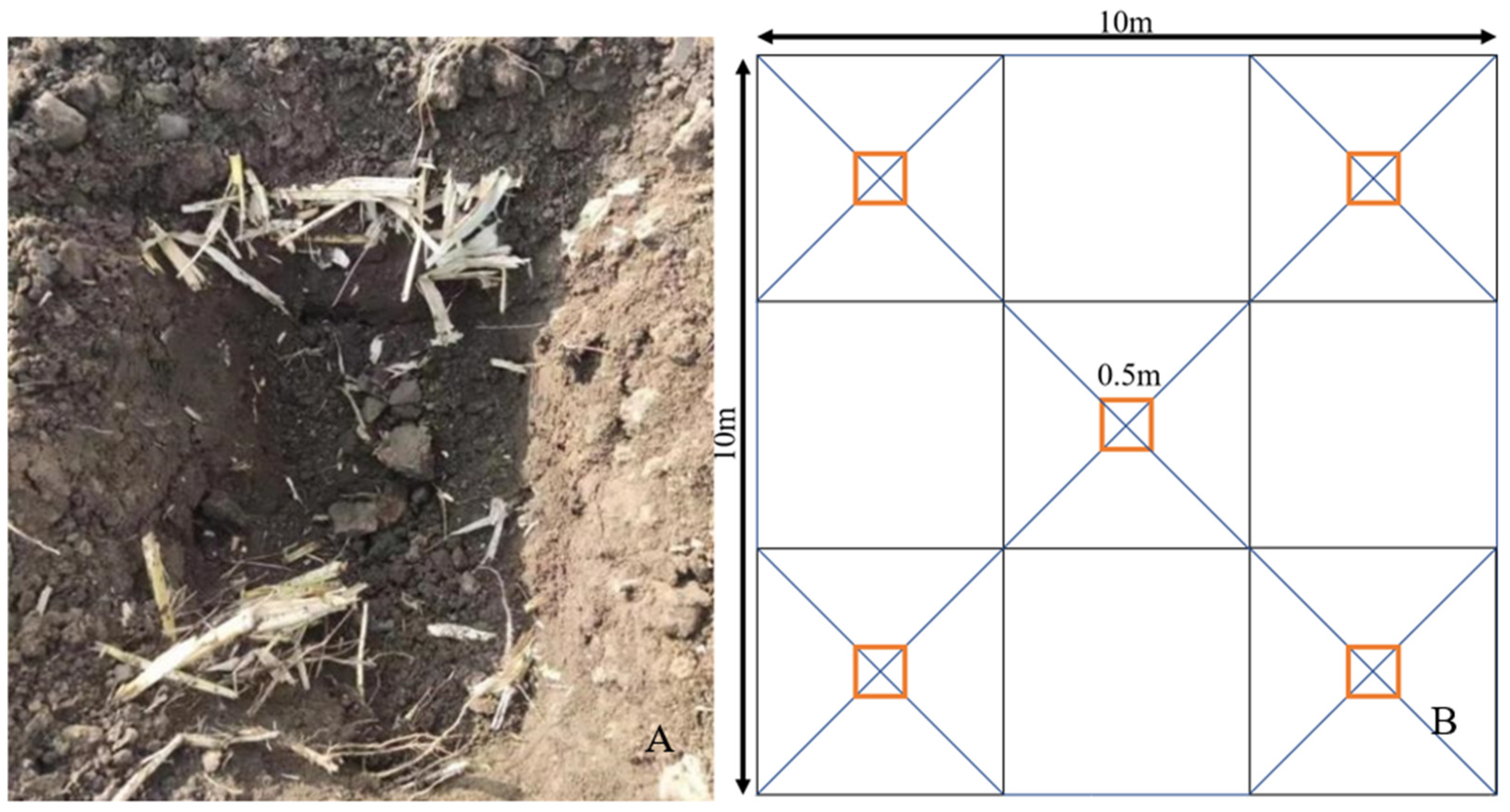
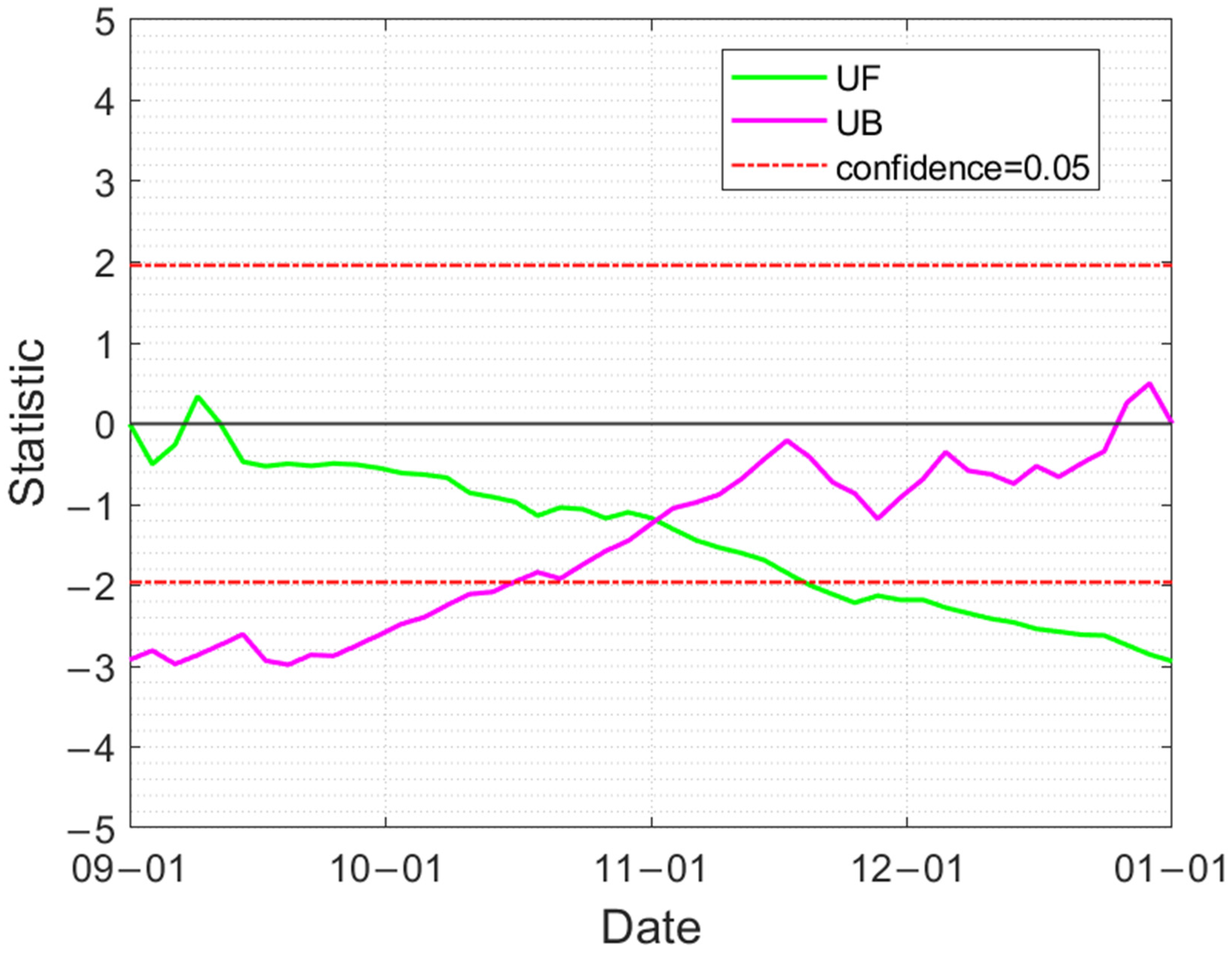
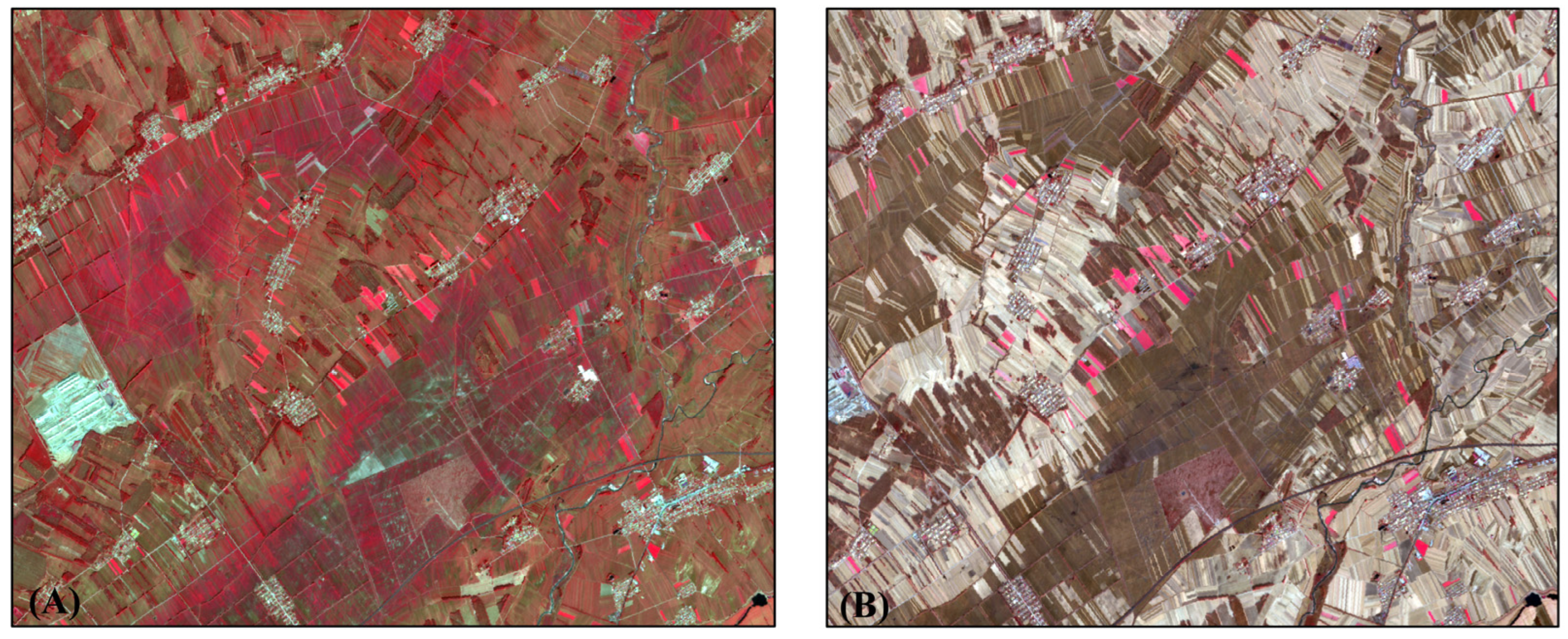
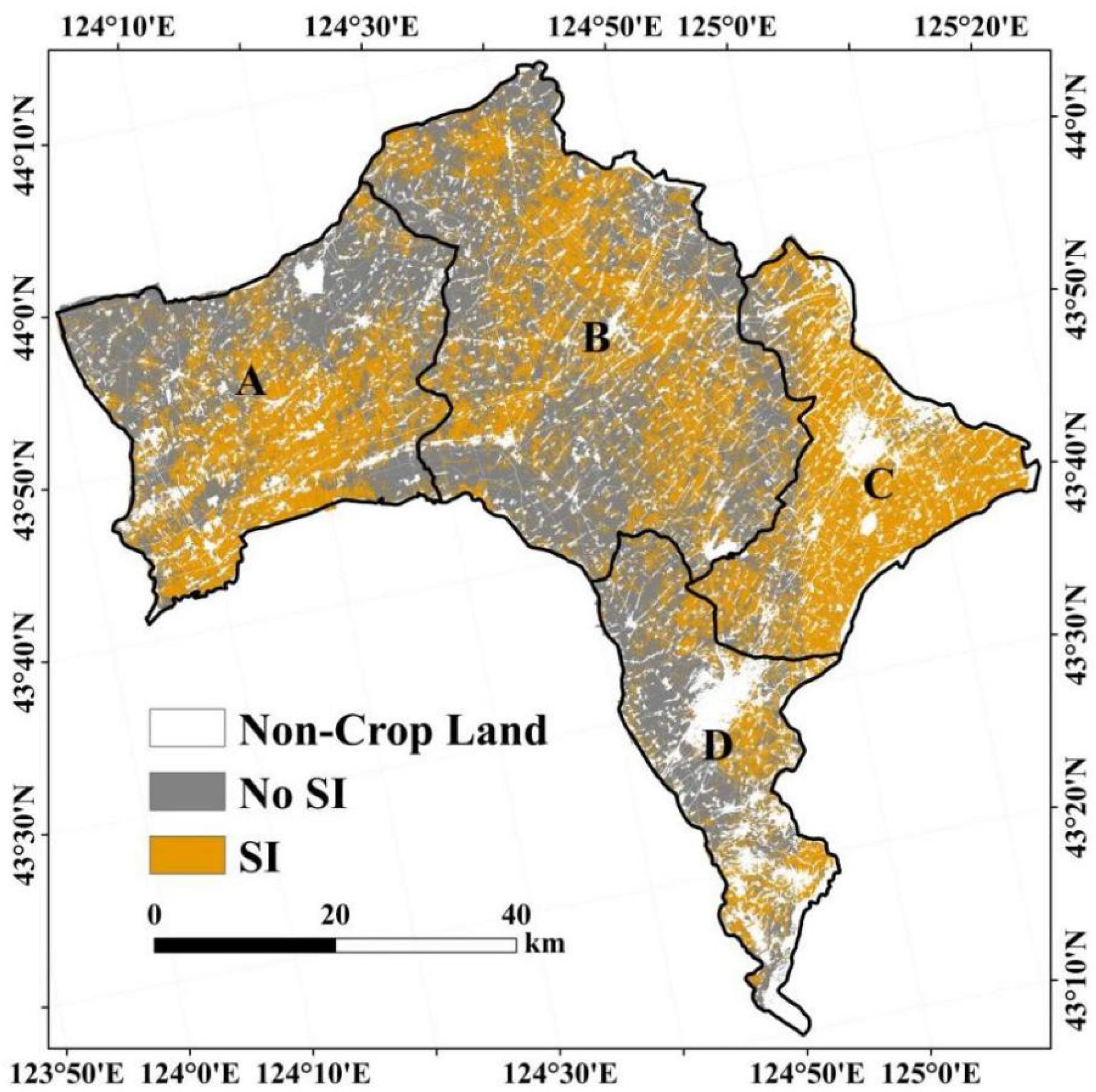
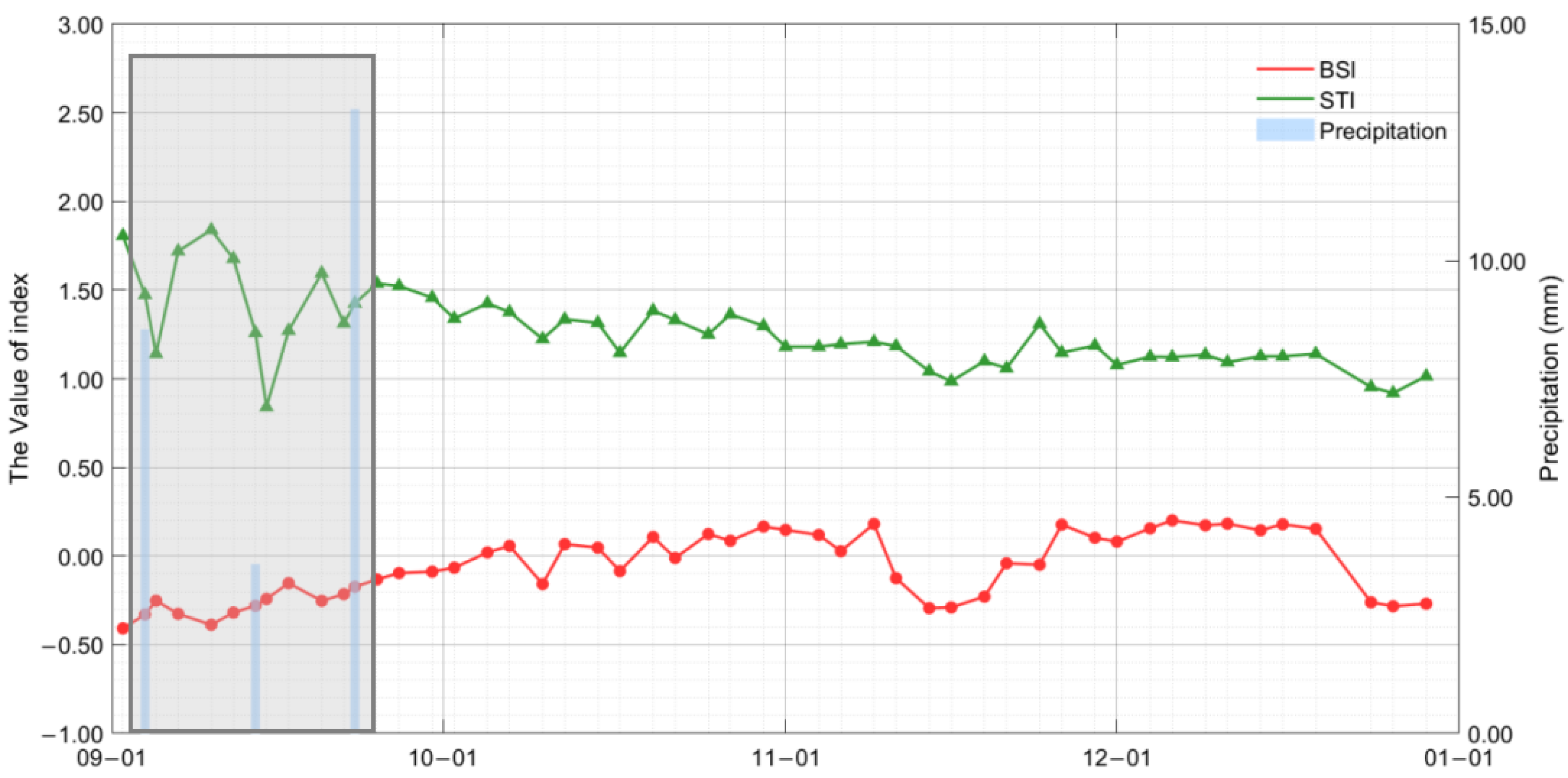

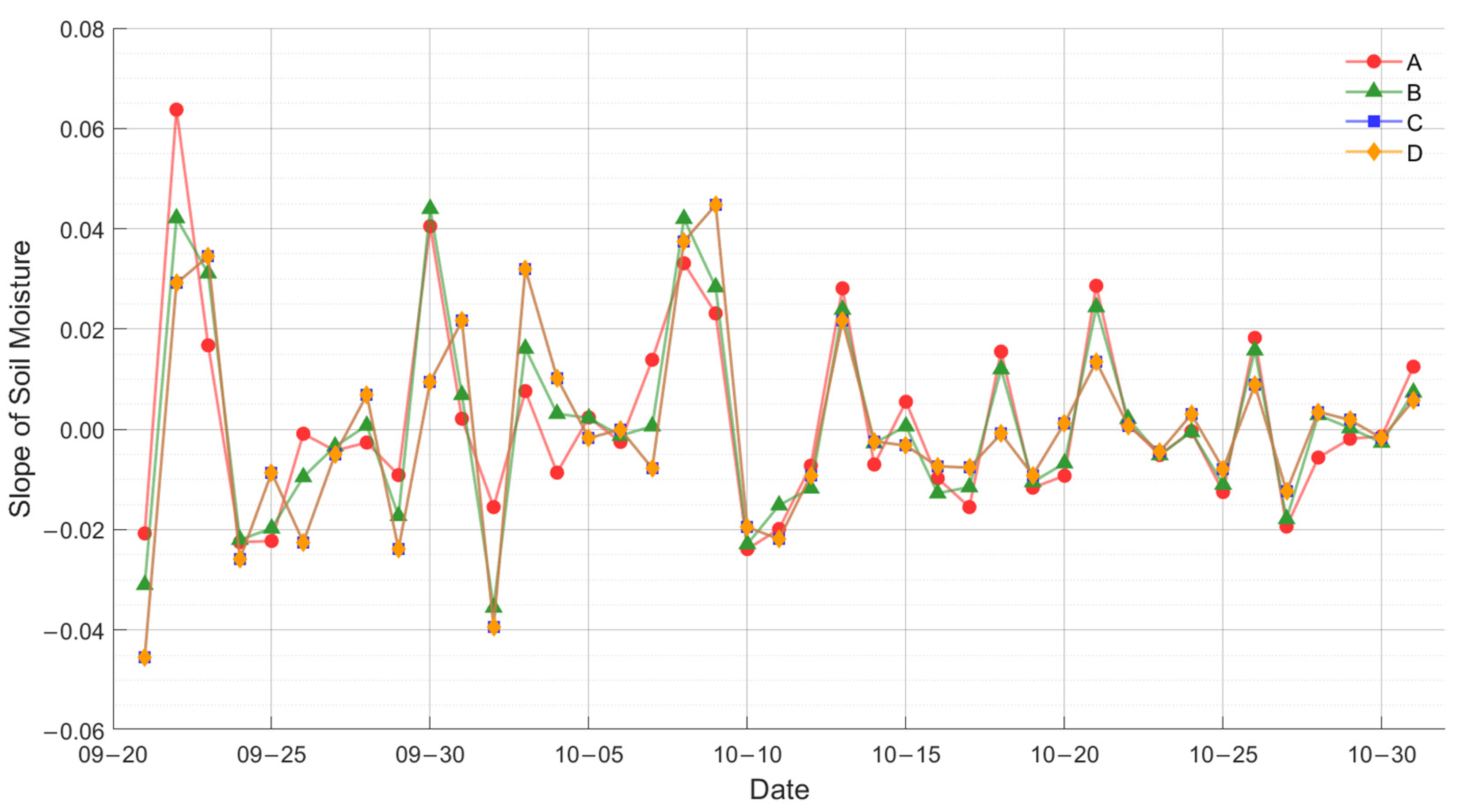
| Spectral Index | Abbreviation | Formula | Ref. |
|---|---|---|---|
| Normalized difference tillage index | NDTI | [81] | |
| Simple tillage index | STI | [81] | |
| Normalized difference index 7 | NDI7 | [82] | |
| Shortwave red normalized difference index | SRNDI | [83] | |
| Normalized difference index 5 | NDI5 | [82] | |
| Normalized difference senescent vegetation index | NDSVI | [84] | |
| Modified crop residue cover | MCRC | [85] | |
| Bare soil index | BSI | [86] |
| Spectral Indices | Range | OA | PA | UA |
|---|---|---|---|---|
| NDTI | [−1,1] | 0.28 | 0.75 | 0.19 |
| STI | 0.85 | 0.97 | 0.85 | |
| NDI7 | [−1,1] | 0.33 | 0.72 | 0.29 |
| SRNDI | [−1,1] | 0.36 | 0.95 | 0.23 |
| NDI5 | [−1,1] | 0.36 | 0.74 | 0.36 |
| NDSVI | [−1,1] | 0.45 | 0.93 | 0.36 |
| MCRC | [−1,1] | 0.47 | 0.94 | 0.38 |
| BSI | [−1,1] | 0.84 | 0.93 | 0.87 |
| Day | Weather Conditions | ||
|---|---|---|---|
| 9.05 | Cloudy | 0 | 0 |
| 9.15 | Mid-rain | 0 | 0 |
| 9.22 | Mid-rain | 0 | 0 |
| 9.30 | Light rain | 2 | 0 |
| 10.10 | Mid-rain | 0 | 0 |
| 10.17 | Cloudy | 0 | 0 |
| 11.11 | Snow | −2 | −2 |
| 12.24 | Snow | −2 | −2 |
| Cost (RMB/ha) | Subsidy (RMB/ha) | Subsidy − Cost (RMB/ha) | Revenue (RMB/ha) | Revenue − Cost + Subsidy (RMB/ha) | |
|---|---|---|---|---|---|
| SI | 1500 | 750–1050 | 450 − 750 | 685–1039 | −65 − 589 |
Disclaimer/Publisher’s Note: The statements, opinions and data contained in all publications are solely those of the individual author(s) and contributor(s) and not of MDPI and/or the editor(s). MDPI and/or the editor(s) disclaim responsibility for any injury to people or property resulting from any ideas, methods, instructions or products referred to in the content. |
© 2025 by the authors. Licensee MDPI, Basel, Switzerland. This article is an open access article distributed under the terms and conditions of the Creative Commons Attribution (CC BY) license (https://creativecommons.org/licenses/by/4.0/).
Share and Cite
Li, J.; Zhang, W.; Du, J.; Song, K.; Yu, W.; Qin, J.; Liang, Z.; Shao, K.; Zhuo, K.; Han, Y.; et al. Detecting Temporal Trends in Straw Incorporation Using Sentinel-2 Imagery: A Mann-Kendall Test Approach in Household Mode. Remote Sens. 2025, 17, 933. https://doi.org/10.3390/rs17050933
Li J, Zhang W, Du J, Song K, Yu W, Qin J, Liang Z, Shao K, Zhuo K, Han Y, et al. Detecting Temporal Trends in Straw Incorporation Using Sentinel-2 Imagery: A Mann-Kendall Test Approach in Household Mode. Remote Sensing. 2025; 17(5):933. https://doi.org/10.3390/rs17050933
Chicago/Turabian StyleLi, Jian, Weijian Zhang, Jia Du, Kaishan Song, Weilin Yu, Jie Qin, Zhengwei Liang, Kewen Shao, Kaizeng Zhuo, Yu Han, and et al. 2025. "Detecting Temporal Trends in Straw Incorporation Using Sentinel-2 Imagery: A Mann-Kendall Test Approach in Household Mode" Remote Sensing 17, no. 5: 933. https://doi.org/10.3390/rs17050933
APA StyleLi, J., Zhang, W., Du, J., Song, K., Yu, W., Qin, J., Liang, Z., Shao, K., Zhuo, K., Han, Y., & Zhang, C. (2025). Detecting Temporal Trends in Straw Incorporation Using Sentinel-2 Imagery: A Mann-Kendall Test Approach in Household Mode. Remote Sensing, 17(5), 933. https://doi.org/10.3390/rs17050933








